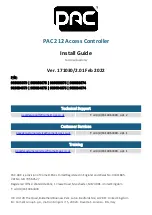
473
/
838
Nations Technologies Inc.
Tel
:
+86-755-86309900
:
Address: Nations Tower, #109 Baoshen Road, Hi-tech Park North.
Nanshan District, Shenzhen, 518057, P.R.China
Whether to support suspend/resume operations is optional. Following are the steps to perform a suspend/resume
operation on the MMC/SD bus:
1.
Determine the current function of the data line (SDIO_DAT[3:0])
2.
Request to suspend low-priority or slow operations
3.
Wait for the pause operation to complete and confirm that the device has been paused
4.
Start the transfer of the high-priority device
5.
Wait for the high-priority device to complete the transfer
6.
Resume from a suspend operation
I/O ReadWait
The Read Wait operation is optional and only works in 1-bit or 4-bit mode of the SD card. The read wait operation
means that when a card is reading multiple registers (IO_RW_EXTENDED, CMD53), the MMC/SD module can ask
it to temporarily stop data transmission, and at the same time allow the MMC/SD module to send commands to other
functions in the SD I/O device. The MMC/SD module can judge whether a card supports the read waiting protocol
by detecting the internal registers of the card. The read wait time is related to the interrupt phase.
Commands and responses
18.5.1
Application related commands and general commands
The SD card host module system is a standard interface, which is suitable for a variety of application types, while
taking into account specific users and applications, so two types of general commands are defined in the standard:
application-related commands (ACMD) and general commands (GEN_CMD) .
When the card receives the APP_CMD (CMD55) command, the card expects the next command to be an application
related command. Application Dependent Commands (ACMD) and normal multimedia card commands have the
same format structure, and they can also use the same CMD number. Because it appears after APP_CMD (CMD55),
the card recognizes it as an ACMD command. If the APP_CMD(CMD55) command is not followed by a defined
application-related command, it is recognized as a standard command; for example: if CMD13
(SD_STATUS(ACMD13) is defined in the application) is received immediately after APP_CMD(CMD55), it will
Interpreted as SD_STATUS (ACMD13); but if the card receives CMD7 immediately after APP_CMD (CMD55), and
the card does not define ACMD7, it will be interpreted as a standard CMD7 (SELECT/DESELECT_CARD)
command.
If you want to use the manufacturer-defined ACMD, the SD card host needs to do the following:
1.
Send APP_CMD (CMD55) command
2.
The card returns a response to the multimedia/SD card module, indicating that the APP_CMD bit is set and
waiting for the ACMD command.
3.
Send the specified ACMD
4.
The card returns a response to the multimedia/SD card module, the response indicates that the APP_CMD bit is
set, and the received command has been correctly parsed according to the ACMD command; if the received
















































